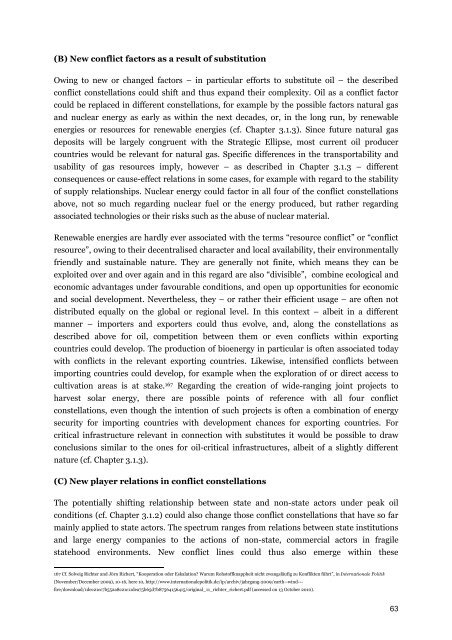PEAK OIL
PEAK OIL
PEAK OIL
Create successful ePaper yourself
Turn your PDF publications into a flip-book with our unique Google optimized e-Paper software.
(B) New conflict factors as a result of substitution<br />
Owing to new or changed factors – in particular efforts to substitute oil – the described<br />
conflict constellations could shift and thus expand their complexity. Oil as a conflict factor<br />
could be replaced in different constellations, for example by the possible factors natural gas<br />
and nuclear energy as early as within the next decades, or, in the long run, by renewable<br />
energies or resources for renewable energies (cf. Chapter 3.1.3). Since future natural gas<br />
deposits will be largely congruent with the Strategic Ellipse, most current oil producer<br />
countries would be relevant for natural gas. Specific differences in the transportability and<br />
usability of gas resources imply, however – as described in Chapter 3.1.3 – different<br />
consequences or cause-effect relations in some cases, for example with regard to the stability<br />
of supply relationships. Nuclear energy could factor in all four of the conflict constellations<br />
above, not so much regarding nuclear fuel or the energy produced, but rather regarding<br />
associated technologies or their risks such as the abuse of nuclear material.<br />
Renewable energies are hardly ever associated with the terms “resource conflict” or “conflict<br />
resource”, owing to their decentralised character and local availability, their environmentally<br />
friendly and sustainable nature. They are generally not finite, which means they can be<br />
exploited over and over again and in this regard are also “divisible”, combine ecological and<br />
economic advantages under favourable conditions, and open up opportunities for economic<br />
and social development. Nevertheless, they – or rather their efficient usage – are often not<br />
distributed equally on the global or regional level. In this context – albeit in a different<br />
manner – importers and exporters could thus evolve, and, along the constellations as<br />
described above for oil, competition between them or even conflicts within exporting<br />
countries could develop. The production of bioenergy in particular is often associated today<br />
with conflicts in the relevant exporting countries. Likewise, intensified conflicts between<br />
importing countries could develop, for example when the exploration of or direct access to<br />
cultivation areas is at stake. 167 Regarding the creation of wide-ranging joint projects to<br />
harvest solar energy, there are possible points of reference with all four conflict<br />
constellations, even though the intention of such projects is often a combination of energy<br />
security for importing countries with development chances for exporting countries. For<br />
critical infrastructure relevant in connection with substitutes it would be possible to draw<br />
conclusions similar to the ones for oil-critical infrastructures, albeit of a slightly different<br />
nature (cf. Chapter 3.1.3).<br />
(C) New player relations in conflict constellations<br />
The potentially shifting relationship between state and non-state actors under peak oil<br />
conditions (cf. Chapter 3.1.2) could also change those conflict constellations that have so far<br />
mainly applied to state actors. The spectrum ranges from relations between state institutions<br />
and large energy companies to the actions of non-state, commercial actors in fragile<br />
statehood environments. New conflict lines could thus also emerge within these<br />
167 Cf. Solveig Richter and Jörn Richert, “Kooperation oder Eskalation? Warum Rohstoffknappheit nicht zwangsläufig zu Konflikten führt”, in Internationale Politik<br />
(November/December 2009), 10-16, here 10, http://www.internationalepolitik.de/ip/archiv/jahrgang-2009/earth--wind-fire/download/1dec21cc7b552a8c21c11dea75b65d7b87564156415/original_11_richter_richert.pdf<br />
(accessed on 13 October 2010).<br />
63


